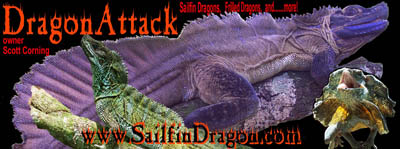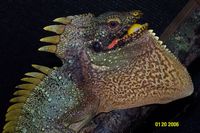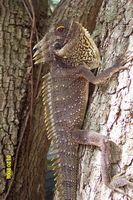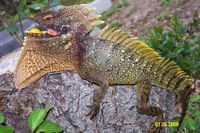General Information and Husbandry Techniques
Also commonly known as Tree dragons, River dragons, Forest Dragons, Rainforest dragons, Angle-Headed lizards, Combed dragons etc....these lizards mainly comprise the genus Gonocephalus(16 species) and Hypsilurus(at least 20 species but now divided with three formerly known species H. dilophus, H. boydii, and H. spinipes into the genus Lophosaurus) of the Agamid family. Gonocephalus distribution includes the western side of Wallace's Line, as well as western Indonesia & Malaysia. Hypsilurus distribution encompasses the eastern side of Wallace's Line, on into Irian Jaya, and the surrounding islands such as New Guinea & the Solomon Islands, and then down through Australia. The Gonocephalus attain lengths mostly on the smaller side, from ~8"-30", whereas Hypsilurus are a bit on the larger side, from ~14" to well over 36"!
I've been working with these lizards since 1995 and in general these lizards are insectivorous to omnivorous rainforest dwellers, living primarily on the trees and dependant on the daily rain cycles and dew buildup for their hydration. Many are found near rivers and streams, and some way up in the canopy. Several species are capable swimmers such as Gonocephalus grandis. We need to keep this in mind when planning a captive environment for them. I have worked with several species of Gonocephalus and Hypsilurus over the years and they can be a bit fragile and tricky at first. I had great success many years ago with Gonocephalus grandis, the largest of the Gonocephalus. I was able to keep the colony and successfully breed, hatch and rear them with a bit of trial and error due to the lack of information available. I'm more interested in keeping and breeding the larger lizards, so am more focused on the genus Hypsilurus.
Caging
With medium sized arboreal lizards, a large terrarium is needed to mentally and physically allow these lizards to live a healthy life in captivity. Similar to the information I've provided for the Hydrosaurus genus, branches of many diameters should be placed throughout the cage (vertically as well as horizontally), with even more branches available to them as compared to Hydrosaurus. Also needed is some type of leafy cover, using either silk, real plants or both. Several areas must be available to bask under a heat lamp, and an UVB reptile light for vitamin D3 production is recommended with a good 12-14 hour daily light cycle. The average temps - depending on species - should range between an ambient 77F to 95F throughout the day with a 5 to 10 degree drop at night for most species, and probably an overall 10 degrees lower for any montane species. A taller than longer cage will also provide a more secure feeling habitat as these lizards tend to "hang out" up off the ground and only come down when feeding off the forest floor, or to work on their reproductive techniques. A large heated water basin could provide a nice humid environment, and a bubbler in the water may entice them to come down to drink and defecate if necessary. Spraying down the cage 2-3 times a day using a hand sprayer or an electronic misting system will create a similar feel to the habitat of the wild. It is a very good idea to have your cage inescapable not only to the lizards but to the insects as well. It's great to have an escape proof cage in order for the dragons to be able to forage for food or snatch an insect that is crawling up a branch next to them; this form of exercise is good because some species do not really get around all that much.
Feeding
As these lizards are primarily insectivorous to omnivorous, it creates an interesting job for the keeper to expand on what we would commonly feed our captive lizards. Crickets and superworms are ok, but there needs to be more variety. With a larger range of food, the lizards will show their appreciation with a better appetite, healthier longer life, and an overall nicer appearance. Roaches are a great recognizable source to most lizards, as roaches are not uncommon in any parts of the world that lizards inhabit. Larger spiders can be fed from tongs to most of these lizards, once they are used to the keepers actions.
There are now canned grasshoppers and snails available that can also be fed from tongs and often can eventually be fed from a bowl or a vibrating bowl. Of course any live nontoxic insects can be fed from a poison free zone, such as large grasshoppers, locusts, cicadas, katydids, moths, stick insects, caterpillars, worms and possibly some clean feeder fish etc....there is also a chance that some species may eat other lizards, bird eggs, small birds, slugs, fruit, flowers, leaves, you name it. Dusting with calcium and vitamins should be done just as explained with the Hydrosaurus. For fun, one could try and experiment with different fruits, plants or plant matter (flowers or salads) to see if any of these would be accepted as a food item.
Experiences with Hypsilurus dilophus
Commonly named the "Combed Dragon", Lophosaurus dilophus have been my favorite of all the tree dragons that I've kept over the years thus far. They are an extremely difficult lizard to obtain, with different habits than many of the other lizards commonly kept. They make great display animals as they have really large exaggerated spikes with a nice chunky head, and a good overall size reaching around 24". The tail that is not as long as some of the longer tailed varieties, thus making them close to the size of an adult green water dragon in comparison.
These lizards supposedly have a huge range from Irian Jaya into New Guinea. There may be some confusion between L. dilophus and H. modestus, as I see many pictures labeled H. modestus(which is a very small species that looks nothing like H. dilophus). Anyways, in general the typical L. dilophus is a beige lizard when warmed up, with buttery yellow highlights on the large triangular spikes (which run from the neck to halfway point on the tail), and enlarged rough scales on the body feeling similar to holding a softer pinecone. The really cool thing about the yellow highlights is that when they open their mouth, they have a bright yellow tongue and internal lips, with a blood red outer scalation at the corner of their large mouths, very pretty. Since these lizards have a huge range, there will be quite a few variations possible subspecies described in the future.
There are flashes of a mossy green and other rusty/maroon colored patches throughout.........very nice subtle coloration. Females are very similar in appearance with just a bit more petite-ness to them, slightly smaller spikes, head and overall length, and maybe not as intense in coloration but very close. Both sexes legs are fairly thin and gangly as opposed to the Hydrosaurus lizards, whose legs make for some fine dining to those hungry enough to eat a lizard (so I’ve heard!).
Another super cool ornamentation is the oversized "dewlap" which is technically a gular fold/pouch that can extend out when the lizard is threatened, maybe also used during courtship?
Their disposition is an interesting one and their habits are similar to that of a frilled dragon, they are the ultimate "tree huggers" and love to "squirrel" (shift the body to the back side of a branch without going up or down the branch) when scared, so as to remain unseen.
These guys aren’t big fans of moving around, so nose bashing in the proper setup will not occur.........yay!!!
Misting for a good length of time 2-3 times a day is important as one may drink in the morning and another later in the day and so on. The need to keep them properly hydrated is first priority on the list to reduce their demise, which is usually due to kidney failure and or fatty liver disease from poor nutrition and or being overfed.
Back to disposition, they are easily picked off the branch if needed to be held for observation. They are kind of clingy and rarely bite unless you would happen to wave your wormy looking finger in front of them for some crazy reason. They have really large mouths, so am assuming they can take down some large prey items in the wild.
They are generally sit-and-wait predators, but will stray a bit to take down some crickets on a nearby branch or wall, if hungry enough.
Feeding can take some patience, usually a good wakeup spraying and then a tong-ful of a favorite large insect waved right in front of the lizards nose on the branch and you MAY after a few minutes evoke a feeding response. It’s hard to believe these things get by in the wild, probably its just the boring food we offer. Sometimes they slowly open their bright yellow mouths and grab the food from the tongs. I have also theorized before that maybe this bright yellow mouth when opened, has some kind of attraction to insects(like a flower) - but at the same time I don’t see them hanging around with their mouths open when they are hungry, so this display is possibly more of a threat to other animals or a territorial display amongst themselves. Maybe the internals of their bright mouths are just pretty for us humans to enjoy!
In the past I’ve noticed a bit of breeding behaviors, mainly the male would wiggle his tail in typical agamid fashion, sort of like an outta control snake attached to the lizard tail. The females appear to have small clutches of 2-3 eggs, but as of this writing only infertiles - so keep your magical dragon dust handy and wish me good fortune on successfully breeding and hatching this rare beauty.




